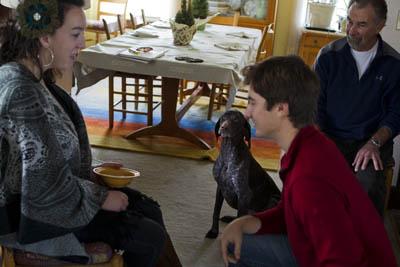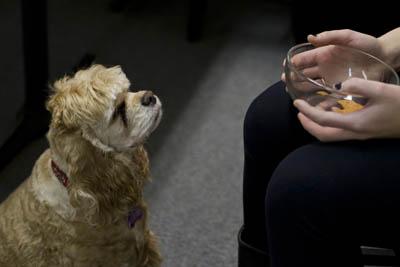Acting Like Animals
Ethan Clotfelter, associate professor of biology and neuroscience and chair of the Department of Biology, answers questions about his course Biology 281: “Animal Behavior.” He taught the course last semester and will offer it again in Fall 2013.
Interview and photos by Rob Mattson
 In a canine cognition experiment as part of Clotfelter's course, students run through a routine of asking for treats in front of Dee the dog, at the home of Professor Jan Dizard. One student declined to give treats to another who asked, while the third gave treats freely.
|
RM: Who typically takes your “Animal Behavior” class?
EC: Most[ly] seniors and juniors, with the occasional sophomore. Most are biology majors, though there are also neuroscience, environmental studies and psychology majors in the course. It can be used to satisfy major requirements in biology, neuroscience and environmental studies.
RM: What careers could your class potentially lead students into?
EC: As biology majors, many students in my class are already on a trajectory toward medical school or graduate school. I’ve had a few students go on to pursue their Ph.D.s in animal behavior or related fields. [The course] certainly helps for students applying to graduate programs in ecology, evolution or behavior (commonly called EEB programs). It also helps students applying to veterinary school. Veterinary schools are putting an increasing emphasis on training in animal behavior, which is entirely appropriate, so I see most of our pre-vet students in my class.
RM: What do they learn over the course of the semester?
EC: Too many things to list here, obviously, but I organize the course into three parts. First, they learn how animal behavior is organized and expressed. They learn about the role of genetics in explaining animal behavior, as well as [about] learning and imprinting processes. They learn a bit [about] neural and endocrine control of behavior and how these allow animals to keep track of time. The second part of the course deals with animals’ interactions with their environment. Topics in this section include: How do animals decide where to live and what to eat? How do they navigate through their surroundings to get from one point to another? Why do animals migrate or hold territories? The third section is about animal social, mating and parental behavior. In this part, we talk about the criteria animals use to select mates and what evolutionary forces select for different mating systems. We talk about social interactions among animals, particularly their behavior toward kin, and the evolution of altruistic and spiteful behavior. We wrap up the course talking about cultural transmission in animals and whether animals display something akin to what we would call “culture.”
RM: Do students conduct research?
EC: Yes, [the course] has a laboratory component. Some of the labs are more prescribed, with an anticipated outcome. In other labs, students design their own experiments and execute them. A big part of the course is helping students to develop hypotheses and to critically test them, with an emphasis on experimental design and data analysis.
RM: What do most students see as the best part of your class?
EC: There are some labs that are very popular with students, such as the falconry lab, the dog cognition lab or the dueling crayfish lab. But I think most students are equally enthusiastic about the lecture material. I know I am.
RM: When did you start observing and examining animal behavior?
EC: I’ve always been fascinated by animals, but my academic interest in animal behavior didn’t really start until I was a senior in college, when I took a course much like this one. I knew almost instantly that this is what I wanted to study.
 Bebop, the cocker spaniel companion of Amherst College Design Director Su Auerbach, sits in front of the student who gave treats, shortly after watching the transactions.
|
RM: What is the allure of animal behavior?
EC: We’ve all watched nature shows on TV and been amazed. We’ve all been children and have wondered “Why do they do that?” I think the allure of this field, and of this class in particular, is that it appeals to this shared curiosity and childlike sense of wonder that we all have.
RM: What role does animal behavior play in the lives of humans as individuals, families, societies and civilizations?
EC: Well, as long as humans (and our prehuman ancestors) have needed to hunt and fish, we’ve needed to understand animal behavior. Tracking animal movements such as migration has long been key to our survival. Similarly, the early domestication of wild animals required an understanding of behavior. But even aside from this practical usage, an understanding of animal behavior—for example, primate behavior—gives us great insight into our own evolution.